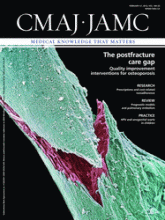Stop the fighting and play hockey
Chronic traumatic encephalopathy (CTE) is associated with memory disturbance, behavioural and personality changes, Parkinsonism, and speech and gait abnormalities. Hockey has now been added to the list of sporting activities that result in CTE. Head trauma in hockey has several causes, which include fighting and direct intentional hits to the head. Supporters of fighting argue that it has always been integral to the game. This brutal tradition should be given up now that research has shown that repeated head trauma can cause severe progressive brain damage. See Editorial, page 275
Improving follow-up

Image courtesy of © 2012 Thinkstock
Writing a letter to a patient’s primary care physician following a fracture of the hip, spine, humerus or forearm resulted in an absolute increase of 14.9% in people receiving testing and treatment for osteoporosis. More than 4000 patients were identified and followed up using routine data systems in this randomized controlled trial. This notification system is relatively simple to implement, say Leslie and colleagues. See Research, page 290
Secondary prevention of osteoporosis among older patients who present with a fragility fracture should be associated with very high quality of care, but few patients receive bone mineral density testing or osteoporosis medications in the 6–12 months postfracture. Although the interventions reported by Leslie and colleagues show only modest improvements over usual care, they are worth pursuing. See Commentary, page 279
Prescribed but not taken
One in ten Canadians do not take their prescription medications because of costs. From their analysis of 5732 respondents to the Canadian Community Health Survey, Law and colleagues determined that insurance coverage was a major factor in explaining this finding. Reducing cost-related nonadherence would likely improve health, say the authors. See Research, page 297
Better literature searches
PubMed search filters can improve the efficiency of literature searches by physicians. This finding is based on a survey of nephrologists asking them to specify search terms to find medical literature to answer clinical questions. Improved searches may enhance the transfer of research into practice and improve patient care, say the authors. See Research, page E184
Accuracy of depression screening
Suitable cut-off scores for the commonly used PHQ-9 depression screening tool include the range between 8 and 11. This meta-analysis of 18 diagnostic validation studies examined the variation in sensitivity and specificity with different cutoff scores. The optimal cut-off score may differ depending on the setting, say the authors. See Research, page E191

Image courtesy of © 2012 Thinkstock
Although the conventional score for diagnosing depression with the brief Patient Health Questionnaire (PHQ-9) has been 10, a wider range (8–12) may be more appropriate depending on the patient population, says Kroenke. See Commentary, page 281
Future concepts in pulmonary embolism

Image courtesy of © 2012 Thinkstock
Can patients with acute pulmonary embolism receive treatment at home? When is it safe to stop anticoagulation? Geersing and colleagues show how prognostic models can be used to answer these and other questions. See Review, page 305
Systemic lupus erythematosus
A 60-year-old woman with systemic lupus erythematosus developed sudden bilateral loss of vision, along with a mild rash on her arms and legs. Although supporting test results were not back, emergency treatment was started after ophthalmologic examination. See Practice, page 315
Unilateral laterothoracic exanthema

Unilateral laterothoracic exanthem, which is commonly mistaken for contact dermatitis, begins in the axilla and spreads centrifugally. It usually occurs in children between one and five years of age in the winter and spring and resolves spontaneously within four to six weeks. See Practice, page 322








